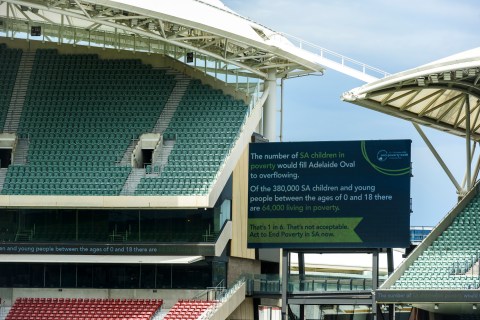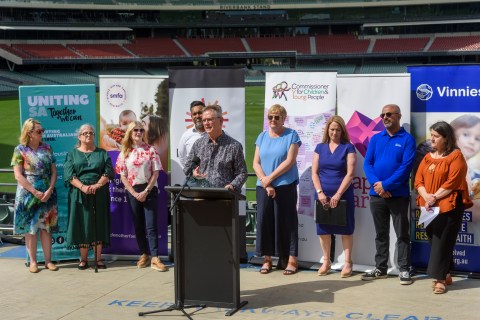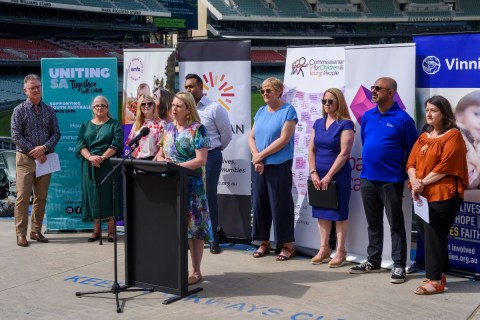Questioning a poor response to an anti-poverty message
An odd press conference at Adelaide Oval last week has prompted questions about how to get society focused on tackling child poverty.

Last Thursday, South Australia’s most senior children’s advocate and eight community service chief executives gathered at an empty Adelaide Oval for a press conference to highlight the extent of child poverty in South Australia.
The idea? Use the stadium’s 53,000 vacant seats as a visual marker for the estimated 64,000 South Australian children living under the poverty line.
“The number of SA children in poverty would fill Adelaide Oval to overflowing,” read a message emblazoned on Adelaide Oval’s three digital scoreboards that morning.
Organisers hired a professional photographer for the event and set the stage for the press conference in front of the northern hill; a lectern, microphone and six advertising backdrops were readied for the cavalcade of not-for-profit leaders to say their piece and take questions from reporters.
In an event that required a considerable amount of legwork and diary coordination, only one thing didn’t go to plan.
No media showed up.
That includes this reporter from InDaily, who like many others was busy covering the fallout of last week’s chaotic abortion debate in parliament.
The no-press press conference still went ahead, even if it felt a bit weird for those speaking.
“We had these eight to 10 CEOs from key large charitable sector organisations from across the state all gathered there and we said, ‘well, we should just get on and present the media conference as we would have done’,” said Ross Womersley, chief executive of the South Australian Council of Social Service (SACOSS).

Womersley has been speaking to South Australia’s media about poverty for 15 years and says last week’s coverage (or lack thereof) prompted a moment of reflection.
You might like
“We probably ought to try and urgently convene a conversation with the press more broadly around issues of coverage and why it’s not getting the attention we think it deserves,” he said.
Asked why he believed poverty was under-covered, he said: “I think it’s hidden from sight and maybe the media goes through cycles of what it’s paying attention to.
“However, we’ve been in a position where we’ve made sure – and even at [Thursday’s] event – we had made sure that there was someone who might be able to speak directly to the experience of poverty.

“I would have thought with that available to the media there would be much more willingness to provide coverage, and [Thursday’s] event… I think there’d been some real effort made to think carefully about constructing an event that had some visual qualities that were going to be appealing to both the print media with the photos but also potentially to the television media given the context.
“But in this instance, the coverage didn’t result.”
So what’s to blame?
Was it not enough warning given on Thursday morning for the 9.30am event? A factor, yes, on a busy news morning, but an alert was also sent out Wednesday afternoon.
Was it a sign of dwindling media resources in an era of newsroom cuts? With most Adelaide newsrooms stretched and fewer reporters being asked to do more with less, that’s also a factor.
Was it a sign of poverty – even child poverty – not being considered newsworthy enough, or too big an issue to knock off in a quick news item?
The anti-poverty advocates at Thursday’s event now ask: how do we get the media and society interested in covering and addressing poverty?
“If you have any bent for social justice, you can’t be immune to the fact that some people haven’t got food to feed their children or themselves,” Vinnies SA chief executive Evelyn O’Loughlin said.
“There’s got to be a way; we send people to the moon, how is it we can’t eradicate poverty?
“There’s something wrong. There’s something broken, and it’s not the fault of the media. It’s not the biggest issue that people seem to want to talk about as a collective society, and media’s part of that, we’re part of that, we all have to say it’s the most important thing.”
The 64,000 South Australian children living in poverty statistic is based off a 2022 Australian Council of Social Service estimate that one in six children across Australia (16.6 per cent) are living below the poverty line, defined as $489 a week for a single adult and $1027 a week for a couple with two children.
South Australia has more than 380,000 children, with one-sixth roughly equalling 64,000 kids in poverty. Other estimates have put the state’s child poverty rate slightly lower at 11.9 per cent.
Stay informed, daily
“We used to talk about one in four in South Australia, so I think one in six is actually conservative,” Commissioner for Children and Young People Helen Connolly said.
“I’d say it probably is a pretty accurate number; it’s not surprising because I’ve been in this business a long time – I was around when we made the statements about no child living in poverty and it was probably a lot less then.”
Connolly’s office is an independent statutory body established in the wake of the 2015-16 Nyland Royal Commission into Child Protection Systems. She is the state’s most senior advocate for children’s rights.
Connolly believes current media narratives around child poverty get “masked” by other issues, such as youth crime and chronic health problems.
“What happens is that we start talking about the youth crime issue, and then when we unpack who are the kids who are actually engaged in those kinds of activities… you start to find out they’re kids who are often really disadvantaged, who are living in poorer families [and] maybe one of the first kind of crimes that they start doing are about accessing something they don’t have because they see other kids have it,” she said.
“But we jump to it as being a crime issue.
“The other thing is we jump to things being a health issue, so we say look at all these people who are attending hospital, and then we go well maybe that’s because they can’t afford to actually have any preventative healthcare or they’re not getting in to see GPs.
“I am out with kids a lot and I reckon I would have said that one of the universal services that most kids would have had access to were GPs; I now don’t see that, so I know that access to GPs just from the way kids talk about it… it’s not universal anymore.”

Connolly has been advocating for a national Child Poverty Act with clear and measurable poverty reduction targets, believing this is the key to changing the public narrative around poverty.
She argues that former Prime Minister Bob Hawke’s 1987 pledge to end child poverty by 1990 was the last time the issue was front of mind across the nation.
“It’s about strategy and vision and actually make a statement that something’s going to change,” Connolly said.
“We need to make that vision statement that says – a bit like the no child in poverty by 1990 – that maybe we need to make these big statements like no child in poverty by 2034 to give ourselves a little bit longer, because it’s more entrenched I would imagine.
“That sharpens the focus to say what does that look like in terms of a national child poverty taskforce, pulling together a strategy that follows and then an identification of all the levers government does have to pull to get us there.”
O’Loughlin, from Vinnies SA, agrees on this point.
“I think it is a conversation we should start to have,” she said.
“We’ve been very brave in talking about some certain things we hold dear to our hearts and had referendums or different things around same sex marriage and the Voice… and domestic violence and there’s action plans and there’s very very important critical work being done.
“But why can’t we talk about poverty in the same way? Why couldn’t we get the media there?
“And I don’t want that to be a criticism of the media, it’s not about that, it’s ‘is this not important?’”
Vinnies SA operates two crisis accommodation centres for men and women respectively. O’Loughlin says that when government benefits increase, “the call on our services decreases at that time”.
“I drive from Belair to the city every day, I don’t see poverty when I drive. I see poverty when I come to work and I hear and go and visit people and see the stories,” she said.
“Is it not in our faces enough? Do we not see the people living in the tents in the park lands? What is that? I don’t know… I don’t know what the answer is to be perfectly honest.
“But I do know that we should all be working together to really look at this issue.”








